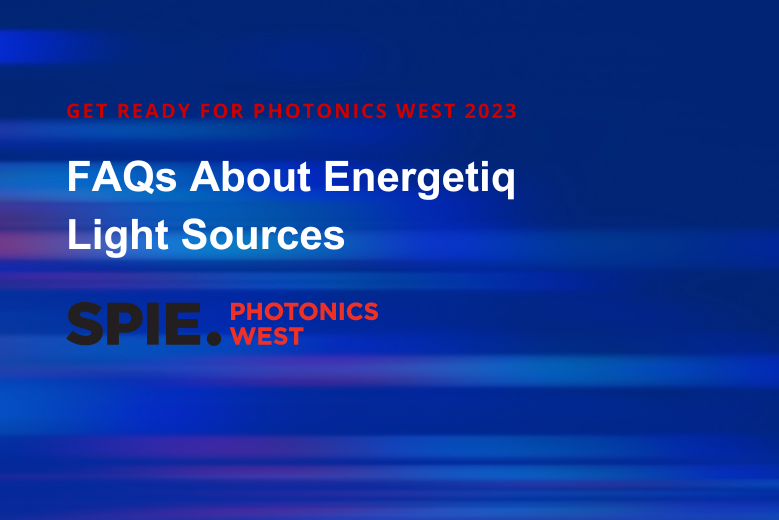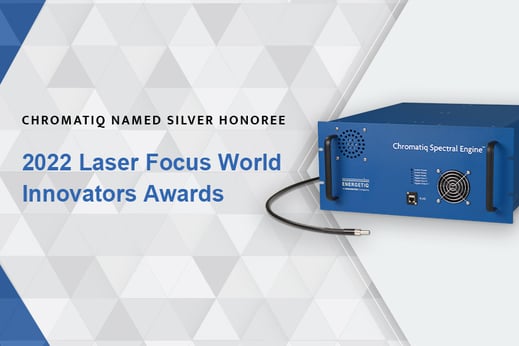Get Ready for Photonics West 2023: Everything About Energetiq Light Sources

Our team at Energetiq couldn’t be more excited for Photonics West where we’ll display everything we’ve been working on, including our award-winning Chromatiq Spectral Engine™ and extended-range Laser-Driven Light Source, the EQ-77C. Our favorite part of tradeshows is having conversations with current and potential customers about how photonics instrumentation and illumination solutions can benefit their applications. Based on conversations we’ve had at previous tradeshows, we compiled a list of FAQs to help shed light on what we do!
Frequently Asked Questions About Energetiq Light Sources
What light sources do you manufacture? Can you explain how they work?
We manufacture broadband light sources for nanoscale illumination. These include our Laser-Driven Light Sources (LDLS®), Tunable Light Sources (LDTLS®), and Chromatiq Spectral Engine™ (CSE). What we mean by “laser-driven” is that we are sustaining a xenon plasma using a laser rather than the electric arc that is typically used in a traditional type of lamp. Our light sources generate high brightness across the spectrum, from UV to infrared and beyond.
We also offer Extreme Ultraviolet Light Sources (EUV) based on our Electrodeless Z-Pinch® technology. We use a patented design to inductively couple current into the plasma and generate ultrashort-wavelength UV radiation. The plasma is magnetically confined away from the source walls which minimizes heat load and debris.
Is the light source a laser?
It is a plasma-based broadband/white light source. Although there isn’t any laser output, there is a laser used to sustain a xenon plasma. This is how light is generated in our LDLS products. The laser itself is a continuous-wave laser.
Our EUV light sources, however, don’t use a laser at all. Instead, they inductively couple a current into the plasma to generate light.
Is the light source coherent?
No, it is an incoherent source. The radiating plasma can be as small as 100 µm in diameter, so for some applications, it can be considered a point source.
Can the light source be pulsed?
No. Since an LDLS light source has a high-pressure Xe gas cell for plasma emission, the cell needs time to warm up to a working temperature. The light source system is not designed for pulse operation. For intermittent light, you can try to use a shutter, a chopper, a galvanometer scanner, or other electro-optic modulators.
What is the wavelength range of the light sources?
The wavelength range differs depending on the product. For (LDLS®) products, the wavelength range is 170 nm – 2500 nm (UV-Vis-NIR). We have a few different (LDTLS®) products that cover different ranges, beginning at 200 nm and extending all the way to 1700 nm. The limiting factor in these sources is the monochromator grating. As for our EUV products, they generate radiation between the deep ultraviolet and x-ray regions (10 nm – 50 nm).
What is the output power of the light sources?
We don’t really talk about our sources in terms of power so much as “brightness” or “radiance.” Spectral radiance is more focused on the concentration of the photons. If you’re looking to illuminate a large area, these might not be the best sources for your needs. We specialize in nanoscale illumination.
What are the light sources used for?
Energetiq light sources can emit many photons from a xenon plasma spot as small as 100 µm in diameter. Because of this, the broadband output can be coupled into many small-etendue optical systems, making our light sources useful in a wide range of applications and industries such as:
Most of our customers are in the semiconductor space and use our light sources for various metrology applications. The LDTLS and CSE sources are targeted toward sensor testing and calibration applications.
We produce extremely bright broadband sources which are a great fit for many illumination applications. Customers in universities and government labs use them as general or multi-use sources. Our sources are also a great fit for astronomical equipment calibration. Click here to see more applications for our light sources!If you have more questions or want to explore our light sources with one of our experts Photonics West, schedule a meeting during the show!
Not able to attend the show this year? Contact our team to discuss potential solutions that we can provide for your application.




